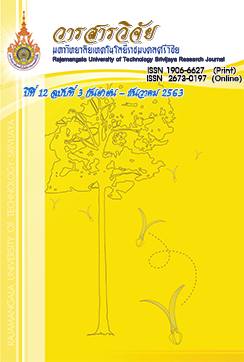Xylanase Production by Candida glabrata Strain SKa4/2 using Agricultural Residues
Keywords:
yeast, xylanase, agricultural residuesAbstract
Xylanase production from Candida glabrata strain SKa4/2 in the medium containing yeast extract as nitrogen source at the different concentration of 0.5 and 1% and carbon sources from glucose or Birchwood xylan at the concentration of 1% was investigated. The result showed that this yeast produced the highest yields of xylanase when grew in the medium containing 1% yeast extract and Birchwood xylan as a carbon source with the enzyme activity of 0.89 UmL-1. Among the different concentration of Birchwood xylan (0.5-1.5%) on xylanase production, the maximum enzyme activity was achieved in the medium containing 1% Birchwood xylan (0.85 UmL-1). Amongst different agricultural waste samples (such as sugarcane bagasse, rice straw and corn husk) as a carbon sources, sugarcane bagasse gave the highest yields of xylanase and the activities was 0.61 UmL-1. This study suggests that sugarcane bagasse could be utilized as a carbon source for economical xylanase production by Candida glabrata strain SKa4/2. This may in turn reduce the cost of enzyme production leading to efficient use of lignocellulosic materials to produce value-added products.
References
Bocchini, D.A., Damiano, V.B., Gomes, E. and Da Silva, R. 2003. Effect of Bacillus circulans D1 thermostable xylanase on biobleaching of eucalyptus Kraft pulp. Applied Biochemistry and Biotechnology 105-108: 393-401.
Damiano, V.B., Bocchini, D.A., Gomes, E. and Da Silva, R. 2003. Application of crude xylanase from Bacillus licheniformis 77-2 to the bleaching of eucalyptus Kraft pulp. World Journal of Microbiology and Biotechnology 19: 139-44.
Gupta, U. and Kar, R. 2008. Optimization and scale up of cellulase free endo xylanase production by solid state fermentation on corn cob and by immobilized cells of a thermotolerant bacterial isolate. Jordan Journal of Biological Science 1: 129-134.
Ho, H.L. 2015. Xylanase production by Bacillus subtilis using carbon source of inexpensive agricultural wastes in two different approaches of submerged fermentation (SmF) and solid state fermentation (SsF). Journal of Food Processing and Technology 6(4): 1-9.
Kamble, R.D. and Jadhav, A.R. 2012. Production, purification and characterisation of alkali stable xylanase from Cellulosimicrobium sp. MTCC 10645. Asian Pacific Journal of Tropical Biomedicine 2(3): S1790-S1797.
Kasemsumran, S., Suttiwijitpukdee, N., Prasatsrisupub, J., Thanapase, W. and Miyata, S. 2010. Determination of chemical constituents in biomass for substitute energy utilization by using near infrared spectroscopy. Agricultural Science Journal 41: 65-68.
Kuhad, R.C. and Singh, A. 1993. Lignocellulose Biotechnology: Current and future prospects. Critical Reviews in Biotechnology 13(2): 151-172.
Kulkarni, N., Shendye, A. and Rao, M. 1999. Molecular and biotechnological aspects of xylanases. FEMS Microbiology Review 23(4): 411-456.
Milagres, A.M.F., Santos, E., Piovan, T. and Roberto, I.C. 2004. Production of xylanase by Thermoascus aurantiacus from sugar cane bagasse in an aerated growth fermenter. Process Biochemistry 39(11): 1387-1391.
Patel, K. and Prajapati, K. 2014. Xylanase production by Cladosporium sp. from agricultural waste. International Journal of Current Research and Academic Review 2(12): 84-90.
Poosarla, V.G. and Chandra, T. 2010. Production of novel halo-alkali-thermo-stable xylanase by a newly isolated moderately halophilic and alkali-tolerant Gracilibacillus sp. TSCPVG. Process Biochemistry 45(10): 1730-1737.
Rajoka, M.I., Ahmed, S., Hashmi, A.S. and Athar, M. 2012. Production of microbial biomass protein from mixed substrates by sequential culture fermentation of Candida utilis and Brevibacterium lactofermentum. Annals of Microbiology 62(3): 1173-1179.
Romdhane, B.I.B., Achouri, I.M. and Belghith, H. 2010. Improvement of highly thermostable xylanases production by Talaromyces thermophilus for the agro-industrials residue hydrolysis. Applied Biochemistry and Biotechnology 162: 1635-1646.
Somogyi, M. 1952. Notes on sugar determination. The Journal of Biological Chemistry 195(1): 19-23.
Suchita, N. and Ramesh, C.K. 2006. Bleaching of wheat straw rich soda pulp with xylanase from a thermoalkalophilic Streptomyces cyaneus SN32. Bioresource Technology 97(18): 2291-2295.
Teixeira, R.S.S., Siqueira, F.G., Souza, M.V., Filho, E.X.F and Bon, E.P.S. 2010. Purification and characterization studies of a thermostable-xylanase from Aspergillus awamori. Journal of Industrial Microbiology and Biotechnology 37: 1041-1051.
Downloads
Published
How to Cite
Issue
Section
License
The content and information in the article published in Journal of Rajamangala University of Technology Srivijaya It is the opinion and responsibility of the author of the article. The editorial journals do not need to agree. Or share any responsibility.







